Practice Free AZ-305 Exam Online Questions
You plan to deploy multiple instances of an Azure web app across several Azure regions.
You need to design an access solution for the app.
The solution must meet the following replication requirements;
• Support rate limiting.
• Balance requests between all instances.
• Ensure that users can access the app in the event of a regional outage.
Solution: You use Azure Traffic Manager to provide access to the app.
Does this meet the goal?
- A . Yes
- B . No
DRAG DROP
You are planning an Azure solution that will host production databases for a high-performance application.
The solution will include the following components:
✑ Two virtual machines that will run Microsoft SQL Server 2016, will be deployed to different data centers in the same Azure region, and will be part of an Always On availability group.
✑ SQL Server data that will be backed up by using the Automated Backup feature of the SQL Server IaaS Agent Extension (SQLIaaSExtension)
You identify the storage priorities for various data types as shown in the following table.

Which storage type should you recommend for each data type? To answer, drag the appropriate storage types to the correct data types. Each storage type may be used once, more than once, or not at all. You may need to drag the split bar between panes or scroll to view content. NOTE: Each correct selection is worth one point.


HOTSPOT
You plan to deploy a custom database solution that will have multiple instances as shown in the following table.

Client applications will access database servers by using db.contoso.com.
You need to recommend load balancing services for the planned deployment.
The solution must meet the following requirements:
✑ Access to at least one database server must be maintained in the event of a regional outage.
✑ The virtual machines must not connect to the internet directly.
What should you include in the recommendation? To answer, select the appropriate options in the answer area. NOTE: Each correct selection is worth one point.
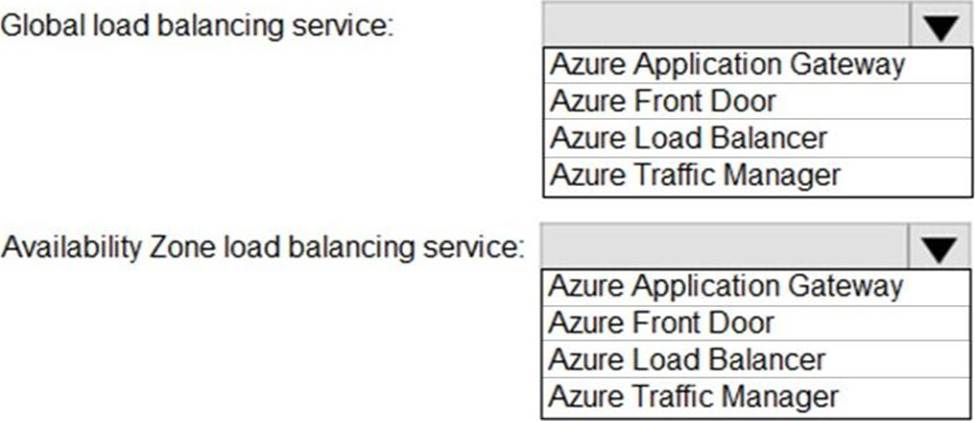
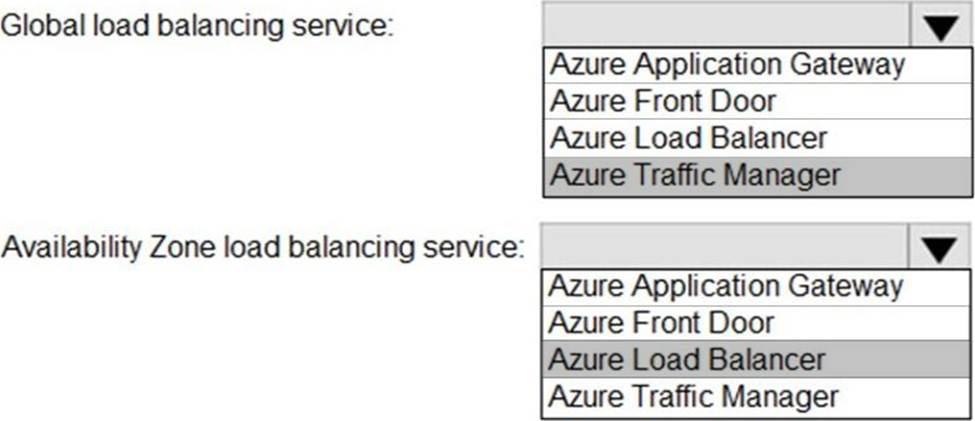
Explanation:
Box 1: Azure Traffic Manager
Traffic Manager is a DNS-based traffic load balancer that enables you to distribute traffic optimally to services across global Azure regions, while providing high availability and responsiveness. Because Traffic Manager is a DNS-based load-balancing service, it load balances only at the domain level. For that reason, it can’t fail over as quickly as Front Door, because of common challenges around DNS caching and systems not honoring DNS TTLs.
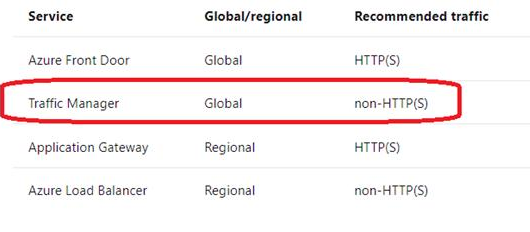
Reference: https://docs.microsoft.com/en-us/azure/architecture/guide/technology-choices/load-balancing-overview
HOTSPOT
You have the Azure subscriptions shown in the following table.

Contoso.onmicrosft.com contains a user named User1.
You need to deploy a solution to protect against ransomware attacks.
The solution must meet the following requirements:
• Ensure that all the resources in Sub1 are backed up by using Azure Backup.
• Require that User1 first be assigned a role for Sub2 before the user can make major changes to the backup configuration.
What should you create in each subscription? To answer, select the appropriate options in the answer area. NOTE: Each correct selection is worth one point.
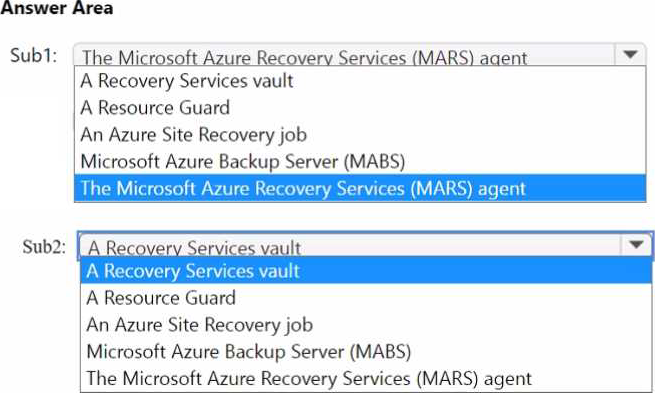
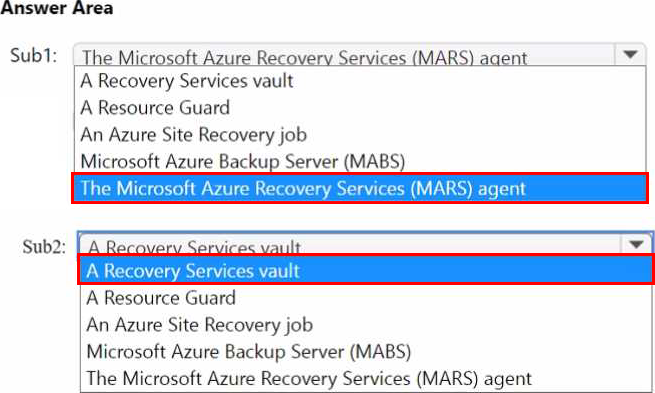
Note: This question is part of a series of questions that present the same scenario. Each question in the series contains a unique solution that might meet the stated goals. Some question sets might have more than one correct solution, while others might not have a correct solution.
After you answer a question in this section, you will NOT be able to return to it. As a result, these questions will not appear in the review screen.
Your company plans to deploy various Azure App Service instances that will use Azure SQL databases.
The App Service instances will be deployed at the same time as the Azure SQL databases.
The company has a regulatory requirement to deploy the App Service instances only to specific Azure regions. The resources for the App Service instances must reside in the same region.
You need to recommend a solution to meet the regulatory requirement.
Solution: You recommend using an Azure policy initiative to enforce the location.
Does this meet the goal?
- A . Yes
- B . No
A
Explanation:
Azure Resource Policy Definitions can be used which can be applied to a specific Resource Group with the App Service instances.
Reference: https://docs.microsoft.com/en-us/azure/governance/policy/overview
You have the Azure resources shown in the following table.
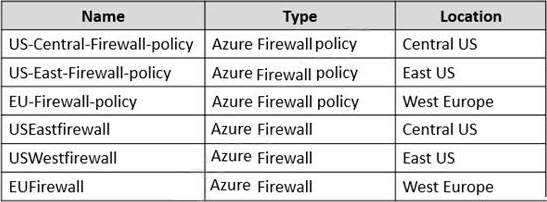
You need to deploy a new Azure Firewall policy that will contain mandatory rules for all Azure Firewall deployments. The new policy will be configured as a parent policy for the existing policies.
What is the minimum number of additional Azure Firewall policies you should create?
- A . 0
- B . 1
- C . 2
- D . 3
B
Explanation:
Firewall policies work across regions and subscriptions.
Place all your global configurations in the parent policy.
Note: Policies can be created in a hierarchy. You can create a parent/global policy that will contain configurations and rules that will apply to all/a number of firewall instances. Then you create a child policy that inherits from the parent; note that rules changes in the parent instantly appear in the child. The child is associated with a firewall and applies configurations/rules from the parent policy and the child policy instantly to the firewall.
Reference: https://aidanfinn.com/?p=22006
You plan to deploy an Azure Databricks Data Science & Engineering workspace and ingest data into the workspace.
Where should you persist the ingested data?
- A . Azure Files
- B . Azure Data Lake
- C . Azure SQL Database
- D . Azure Cosmos DB
B
Explanation:
The Azure Databricks Data Science & Engineering data lands in a data lake for long term persisted storage, in Azure Blob Storage or Azure Data Lake Storage.
Reference: https://docs.microsoft.com/en-us/azure/databricks/scenarios/what-is-azure-databricks-ws
Note: This question is part of a series of questions that present the same scenario. Each question in the series contains a unique solution that might meet the stated goals. Some question sets might have more than one correct solution, while others might not have a correct solution.
After you answer a question in this section, you will NOT be able to return to it. As a result, these questions will not appear in the review screen.
Your company plans to deploy various Azure App Service instances that will use Azure SQL databases.
The App Service instances will be deployed at the same time as the Azure SQL databases.
The company has a regulatory requirement to deploy the App Service instances only to specific Azure regions. The resources for the App Service instances must reside in the same region.
You need to recommend a solution to meet the regulatory requirement.
Solution: You recommend using an Azure Policy initiative to enforce the location of resource groups.
Does this meet the goal?
- A . Yes
- B . No
B
Explanation:
This solution does not meet the goal because an Azure Policy initiative can only enforce the location of resources, not resource groups. Resource groups are not a resource type that can be targeted by Azure Policy1. To enforce the location of resource groups, you need to use Azure Resource Manager templates2 or Azure PowerShell3 to create them in the desired regions.
Reference:
1: Understand scope in Azure Policy
2: Create resource groups with Azure Resource Manager templates
3: Create resource groups with Azure PowerShell
HOTSPOT
You manage a database environment for a Microsoft Volume Licensing customer named Contoso, Ltd. Contoso uses License Mobility through Software Assurance.
You need to deploy 50 databases.
The solution must meet the following requirements:
✑ Support automatic scaling.
✑ Minimize Microsoft SQL Server licensing costs.
What should you include in the solution? To answer, select the appropriate options in the answer area. NOTE: Each correct selection is worth one point.

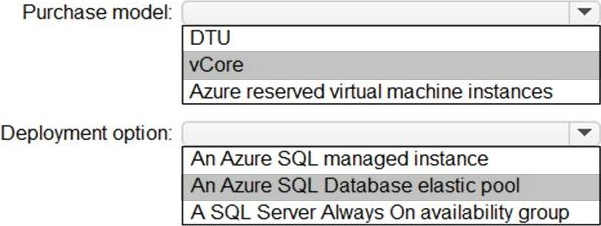
Explanation:
Box 1: vCore
Virtual core (vCore)-based purchasing model (recommended). This purchasing model provides a choice between a provisioned compute tier and a serverless compute tier. With the provisioned compute tier, you choose the exact amount of compute resources that are always provisioned for your workload. With the serverless compute tier, you specify the autoscaling of the compute resources over a configurable compute range
Box 2: An Azure SQL Database Elastic pool
Azure SQL Database provides the following deployment options for a database:
Single database represents a fully managed, isolated database.
Elastic pool is a collection of single databases with a shared set of resources, such as CPU or memory.
Single databases can be moved into and out of an elastic pool.
Reference: https://docs.microsoft.com/en-us/azure/azure-sql/database/purchasing-models
You have an Azure subscription that contains a Basic Azure virtual WAN named Virtual/WAN1 and the virtual hubs shown in the following table.

You have an ExpressRoute circuit in the US East region.
You need to create an ExpressRoute association to VirtualWAN1.
What should you do first?
- A . Upgrade VirtualWAN1 to Standard.
- B . Create a gateway on Hub1.
- C . Create a hub virtual network in US East.
- D . Enable the ExpressRoute premium add-on.
A
Explanation:
US East and US West are in the same geopolitical region so there is no need for enabling ExpressRoute premium add-on https://docs.microsoft.com/en-us/azure/virtual-wan/virtual-wan-about#basicstandard
The current config of virtual WAN is only Basic as given, so it can connect to only site to site VPN, to connect to express route it needs to be upgraded from basic to standard.
https://docs.microsoft.com/en-us/azure/virtual-wan/virtual-wan-about
https://docs.microsoft.com/en-us/azure/virtual-wan/virtual-wan-about
